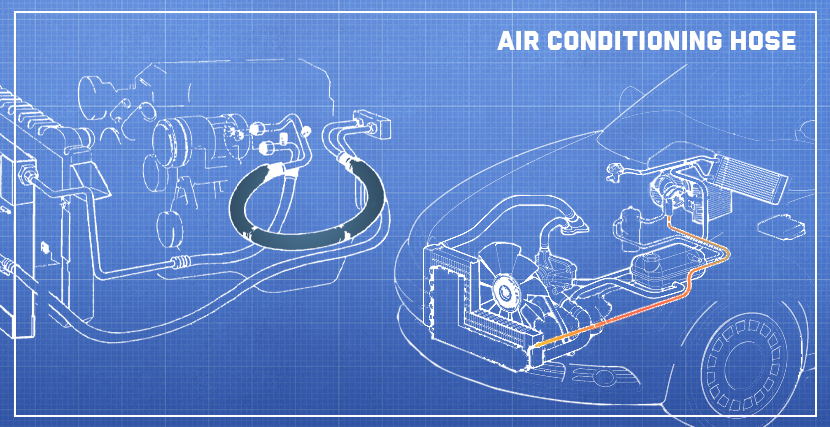Air Conditioning Hose
An air conditioning hose is used to transport refrigerant from the A/C compressor to different parts of the air conditioning system. Made from high-quality durable rubber, it can withstand high pressure and extreme temperatures, allowing for transporting pressurized refrigerant throughout the air conditioning system. An air conditioning hose usually comes with aluminum fittings on the ends for ease of use and installation.

Being exposed to high pressure and extreme temperatures, an air conditioning hose is prone to wear and tear as well as premature failures, causing a number of A/C problems:
There is no cold air blowing from the dashboard's vents
If you notice your air conditioning system doesn’t perform as it should or not blowing cold air, it can be a sign of a leaking or worn-out air conditioning hose. This may lead to loss of refrigerant and a failure of the compressor and other system components. A bad hose must be replaced as soon as possible.
One of your air conditioning hoses is damaged
You can inspect your air conditioning hoses by taking a look at the parts under the hood. If you can detect the A/C hoses in the engine compartment, you will be able to inspect them visually for physical damage. If so, you should pay attention to any cuts, cracks, and abrasions on the hoses. Checking the hoses for leaks, bad hose fittings and exposed threads on the connections should also be in your checklist.
Driving with a faulty air conditioning hose is not the matter of your safety or engine performance. That is all about your comfort and driving experience. Most likely, you’d not like to drive a vehicle with a bad air conditioning hose on a hot summer day.
The other danger of driving a vehicle with a bad air conditioning hose is collecting dust, moisture and dirt inside the A/C components, such as a condenser and a compressor. That’s why we recommend you to fix a bad hose once it is detected. This will prevent you from unplanned and expensive repairs.
Air conditioning hose troubleshooting and replacement
Replacing a bad air conditioning hose must be done by a professional. Its replacement involves a special procedure mandated by federal law. This is required to prevent the refrigerant from escaping into the atmosphere and causing damage to the ozone layer. Here is the list of the steps your mechanic must follow:
- Recover the refrigerant that is left in the system
- Replace a bad hose
- Make a vacuum in the air conditioning system
- Refill the system with refrigerant
- Check the entire system for leaks
- Check if your A/C system performs properly
Before starting a replacement procedure, the mechanic must diagnose the system for leaks and detect a bad hose or another failing component.
It goes without saying that you can’t replace the hose yourself. You must have a universal refrigerant handler’s license or an EPA-approved section 608 license to be allowed to do the trick. That’s why replacing a bad air-conditioning hose must be left to a legal professional who knows how to handle this job properly and has all necessary equipment to do it.